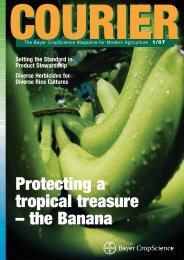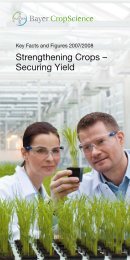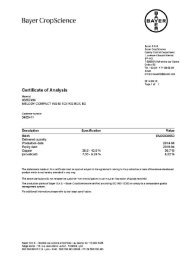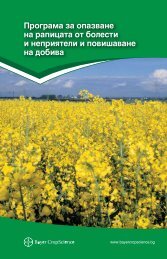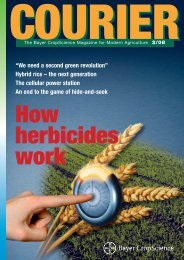Potatoes⦠- Bayer CropScience
Potatoes⦠- Bayer CropScience
Potatoes⦠- Bayer CropScience
Create successful ePaper yourself
Turn your PDF publications into a flip-book with our unique Google optimized e-Paper software.
Some examples of the use of starch as a renewable raw material (from left to right):<br />
Wallpaper paste<br />
Carrier bags<br />
(Photo: novamont)<br />
America and Asia than in Europe. The production<br />
of potato starch for non-nutritional<br />
purposes is predominantly an activity of<br />
Western European nations (although Asia<br />
also uses a smaller amount of potato starch<br />
for industrial purposes).<br />
Each year, more than 9 million tonnes<br />
starch are produced in the European<br />
Union, of which around a fifth derives<br />
from potatoes and the rest from maize and<br />
wheat. Potato starch production in the EU<br />
is fixed by quotas: the total amount is almost<br />
2 million tonnes, of which the largest<br />
share goes to Germany (656,000 tonnes),<br />
followed by the Netherlands (507,000<br />
tonnes) and France (265,000 tonnes). More<br />
than 40% of the starch produced in the<br />
Community is used for non-food purposes.<br />
Native potato starch shows a higher<br />
viscosity than starch from wheat or maize.<br />
It possesses good water-uptake and<br />
swelling properties, as well as low thermal<br />
and electrical conductivity. Its chemical<br />
make-up comprises the carbohydrates<br />
amylose and amylopectin, each of which is<br />
suited to its own set of purposes, although<br />
for most uses, the branched amylopectin<br />
molecule is a more valuable starting material<br />
than the linear amylose. The average<br />
ratio of amylose to amylopectin in potato<br />
starch lies between 1:4 and 1:5.<br />
Late varieties preferred<br />
For starch production, simple late-ripening<br />
potato varieties are preferred. Around 400<br />
varieties of this type exist around the<br />
world. Their starch content of 17 to 20% is<br />
markedly higher than that of food potatoes<br />
(around 10%). On arriving at the starch<br />
factory, the tubers are first washed to<br />
remove any earth still sticking to them.<br />
Next, they are rasped and processed to produce<br />
a slurry, from which the potato starch<br />
is separated and dried in a succession of<br />
steps. The result is a highly pure native<br />
starch with a moisture content of around<br />
20%. A side-product of this process is<br />
potato pulp, which can be returned to the<br />
agricultural production cycle in the form<br />
of protein-rich animal feed.<br />
From glue to fuel<br />
The potato starch is processed further to<br />
produce raw materials for the paper, chemical,<br />
pharmaceutical and textile industries.<br />
The feel, smoothness and shine of the<br />
paper that brings this “Courier“ article to<br />
you could well be attributable to materials<br />
from processed potato starch. Adhesives<br />
derived from potato starch are also valued<br />
in medicine, because they are entirely free of<br />
health concerns: that’s why such adhesives<br />
are found in plasters and dressings. And<br />
many a stamp remains stuck to a holi day<br />
postcard thanks to starch and water.<br />
Potato starches can also be processed<br />
into films, carrier bags, disposable cutlery<br />
and packaging materials. These bio-materials<br />
can replace petroleum oil-based products;<br />
they are capable of being sprayed,<br />
formed or expanded into various shapes<br />
and containers. For example, your last<br />
tee-off at golf may well have been done<br />
from a starch-based tee. Bioplastics would<br />
be especially valuable in restricting the use<br />
of mineral oils and reducing waste if they<br />
were to be used more widely in short-lived<br />
products such as food-packaging, carrier<br />
bags, rubbish sacks and plant pots.<br />
Depending on how they are formulated,<br />
materials based on plant starches are biologically<br />
degradable; composting them<br />
brings the starches back into the production<br />
cycle. At present, the worldwide<br />
capacity for producing bioplastics is less<br />
30 COURIER 1/08





